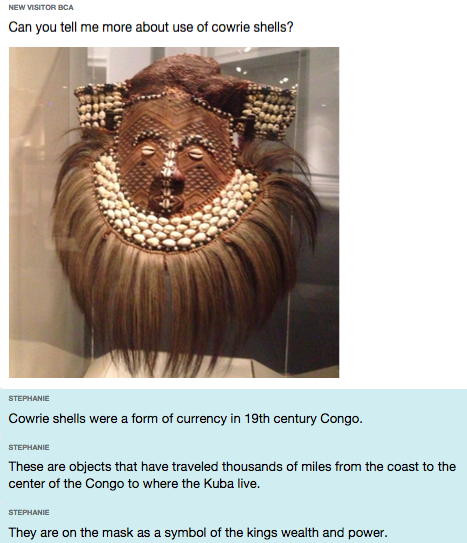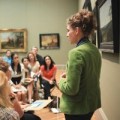The Pedagogy of a Text Message: First Response
In my last post, I discussed our “opening response” and slight tweaks to make that a better experience. Our “first response” (the first message the user receives from the Audience Engagement Team after the user answers the opening response) is equally important because this frames how the user will experience the app and it functions as the hook, encouraging them to continue their app experience.
For our testing of the first response, we wanted to learn if an information-based or inquiry-based first response was most effective at engaging users with art and the app. From the standpoint of the user, what type of response would help the user understand the nature of the app experience, and look more closely at art or engage more deeply with the artwork? From the standpoint of the Team, what type of response was best at providing an immediate response, and what type would be most compelling to the user?
In our first round of tests we experimented with having the first response from the Team be strictly information. The user received the opening prompt, “What work of art are you looking at?” and the Team responded with information only. Information-based responses varied, some provided information about a specific detail that the user would be able to observe on an object; other answers included broader information that provided geographic, historical, or other types of contextual information about the object. For example, here is an exchange the draws the user to look at specific details, and provides contextual information:

In testing information-based responses, we learned users appreciated information—it provided context and a broader view of the object they are looking at, and had the potential to support closer looking. We also learned that the right type of information helps to establish the authority of the Team. Users trusted the app experience more when they believed that the individuals responding to them were knowledgeable, and could offer information that they would not have access to just by looking at the work of art or reading the label.
Our second round of tests experimented using inquiry-based response, the question was simple, and we used the same wording consistently, “What drew you to that object?” A majority of users told us that they liked being posed a question, “I liked being asked the question, it made me look at it [the object] again,” and “I liked that I had to think.” Additionally, using this simple and proscribed first response had the advantage of providing an immediate response to the user, and also helped the Team member have additional time to gather information about the object. While the user was crafting a response, the Team was able to collect information about the object using the Dashboard, and our collection of wikis.
In addition to providing time, using inquiry had the advantage requiring action on the part of the user, and functioned as tool to immediately engage the user with the work. It addressed one of our big picture goals for the ASK app experience — provide visitors with an experience that has them engaged with works of art. By asking, “What drew you to this object?” the Team was able to quickly gather some information about the user’s interest, and helped us engage the user on a more personal level, and generally led to a deeper discussion about the work of art. By answering our question, users found themselves looking back at works of art more closely, and thinking more critically about the objects in the Museum.
With this in mind we will use inquiry as our first response moving forward, and also integrate it into the next version of the opening prompt. In my next blog post I will discuss our process of crafting a new prompt, and what we learned from our second round of testing using inquiry.

Monica Marino is the former Audience Engagement Lead and current School Programs Manager. She is a museum educator with over ten years of experience teaching people of all ages in museums, and training future museum professionals. Over the last ten years Monica has worked in Education here at the Brooklyn Museum, and The Metropolitan Museum of Art. She loves being in discussion with others in front of works of art, and is grateful for the many conversations that have taught her so much about art, and the world.


Start the conversation